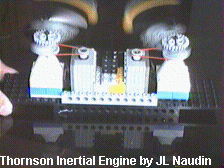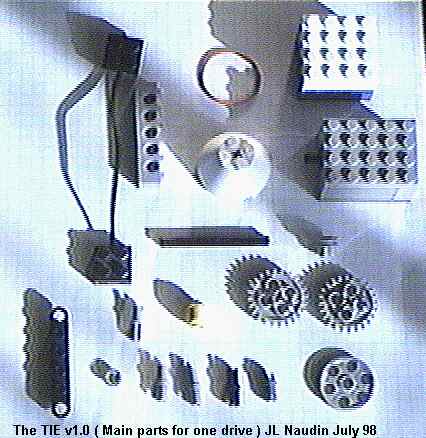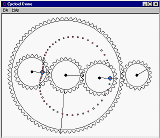
TheThornson Inertial Engine
The T.I.E. V1.0 by JL Naudin
created on 07-29-98 - JLN Labs - last update on 07-30-98
The Thornson Inertial Engine (TIE) uses the force from a rotating inertial mass (the centrifugal force) for producing a linear impulse.
An inertial propulsion engine (IPE) is a mechanical device which uses a standard electrical motor drive for producing a motion.
Some tests and measurements conducted on Thornson Drive prototype have suggested that the IPE force-to-power ratio can be up to 2000% ie 20 times higher than a conventional jet engine. (see the document from Thomas Valone "Inertial propulsion: the Thornson EZKL drives" and also the document from the same author "Inertial Propulsion: Concept and Experiment")
See the Patent : "Apparatus for developping a Force propulsion" by Brandson R. Thornson ( 1986 ) : Patent US4631971

The Thornson drive is composed of eccentric masses which, when rotated properly, causes a cancellation of all forces except in one direction.
Some detailled pictures about the TIE prototype. You may notice the four "slider" fixed on the base, for a successfull experiment, the TIE device must run on a clean and smooth surface like glasse.
The total weight of the TIE V1.0 is 220 gr. The two spinning masses have a very light weight M=1.5 g (each)
I have noticed that a high speed gives better results than heavy rotating masse, because the unidirectional trust is more constant and this reduces the jerky motion.


The rotation sequence of the TIE v1.0
See the Thornson Inertial Engine in action in REAL VIDEO :
( if you don't have the RealPlayer 5.0, you may download it freely at : http://www.real.com/products/player/ )
Additional notes : "In 1990, a 16 foot Grumman canoe and two passengers with a gross weight of 450 pounds demonstrated a low acceleration rate and propulsion of one mph after traveling 75 feet in a swimming pool. The 60 pound Thornson prototype was totally sealed inside a plywood case..." ( from Thomas Valone paper "Inertial propulsion: the Thornson EZKL drives" - PACE Newsletter vol 7-1, 7-4 and Vol 9-4 ).
Comments : In spite of the light rotating weights used (2x1.5 g), the TIE device is able to move itself on smooth surface (for the 220 g TIE slider version), and on water (for the 820 g TIE floating box version)...
See also : The TIE pendulum test
 The
Cycloid software simulator
from Simon
Tillson
The
Cycloid software simulator
from Simon
Tillson
If you need more informations or if you have any suggestions send me your Feedback
![]() Email
: [email protected]
Email
: [email protected]
Return to the Inertial propulsion main page